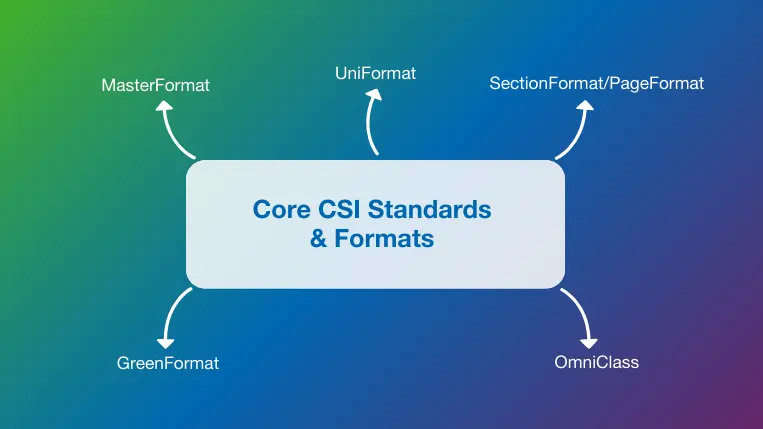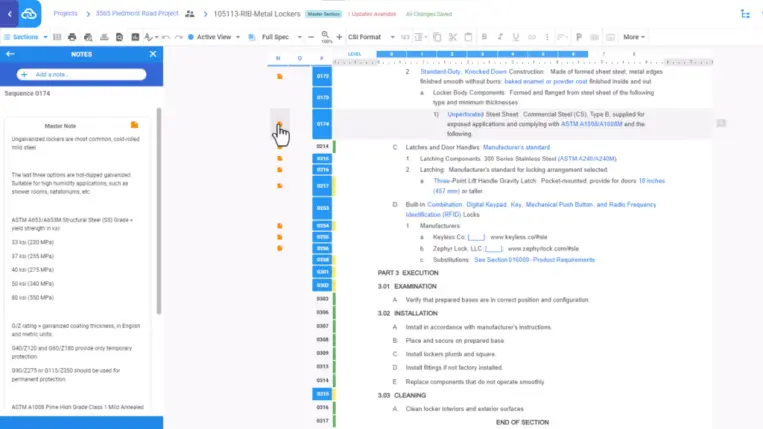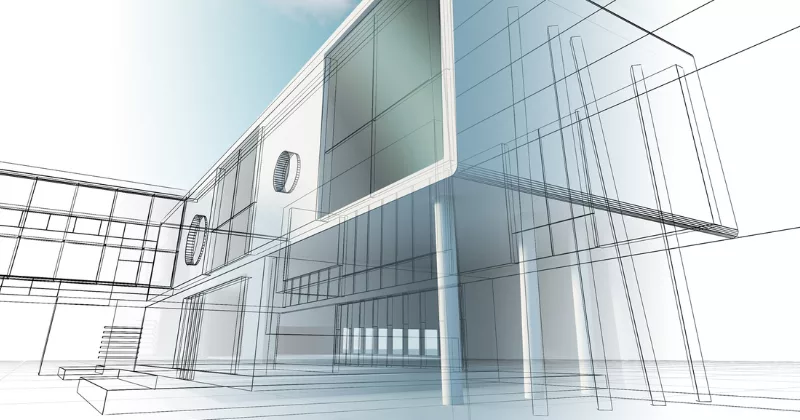11 mins read
What Is the Construction Specifications Institute? History, Standards, and Available Certification Programs

The broad scope of construction project types has always made standardization difficult. Even with advanced cloud-based software tools making it easier to share information and collaborate in real-time, these challenges have continued. Overcoming the obstacles that prevent standardized documentation has been the mission of the Construction Specifications Institute (CSI) for over 75 years.
In this blog post, we examine the history, key standards, and certification programs of the Construction Specifications Institute, which help improve communication and standardize construction documentation and project management practices. We also explore a key software partnership that has expanded the global reach of CSI codes, specifications, and practices.
What Is the Construction Specifications Institute?
The Construction Specifications Institute (CSI) is a not-for-profit organization dedicated to improving communication and efficiency in the construction industry through the development of standard templates, formats, and practices, along with education and certification.
The history of CSI began in 1947, when a group of architects and engineers gathered to discuss ways to standardize construction specifications to boost the industry. By the following year, the Construction Specifications Institute was officially incorporated. The institute’s initial emphasis was education and learning, and this focus remained as dozens of new CSI chapters were established over the next several decades.
CSI provides a forum for engineers, architects, and other construction roles to exchange ideas and information while improving spec quality, clarity, and technical validity. With over 140 chapters and 8,000 active members in North America, these efforts have also led to a greater appreciation of specifications in the overall scope of contract documents.
Core CSI Standards & Formats

Along with advanced training and certification programs designed to keep industry experts grounded in the latest tools and practices, CSI standards and formats create a common language for construction professionals.
MasterFormat
CSI MasterFormat is a numerical system developed to organize construction project information into 50 unique construction specifications institute divisions, each representing a specific work area, such as metals, roofing, concrete, or furnishings. The first version of MasterFormat was published in 1978.
CSI divisions organize project information through a system of numbers and titles. Many of these divisions are broken into additional sections and subsections to improve organization. For example, Division 05 – Metals includes sections for railing, stairs, framing, and other specific construction applications for metals.
UniFormat
CSI UniFormat is a system for classifying building elements, systems, and assemblies. While MasterFormat organizes information based on material types and scope of work (SOW), UniFormat utilizes a systems-based approach to organization based on building content. This provides designers and architects with a framework to classify building elements and estimate project scope during early design phases. Uniformat is also useful for standardizing construction cost analysis and documentation practices.
SectionFormat/PageFormat
This joint publication between CSI and Construction Specifications Canada (CSC) combined two established formatting standards under a common umbrella when it was launched in 2009. The unified standard provides a streamlined approach to presenting and organizing CSI specification sections.
SectionFormat provides a three-part format for arranging text in project manual sections, while PageFormat includes a set of best practices for arranging text on a specification page, along with guidance for page numbering and margins.
OmniClass
This widely used classification system is the result of another collaboration between CSI and CSC. OmniClass uses a series of 15 hierarchical tables to organize project documents, project literature, and library materials. This system is especially useful for organizing the project libraries that support building information modeling (BIM) design and construction management practices.
GreenFormat
GreenFormat is a free, web-based database that allows manufacturers to enter information on the sustainable aspects of their products, systems, and materials. This service leverages the established CSI construction divisions to improve searchability and consistency with other CSI standards. GreenFormat also incorporates requirements like the LEED Green Building Rating System to align with other accepted sustainable construction criteria.
What Is the Importance of the CSI for the Construction Industry?
The construction industry is known for supporting a wide variety of management practices, regulatory requirements, and project types, as well as a long list of contract documents that must accompany each new endeavor. Standard practices for formatting and organizing this information help improve communication between stakeholders. Construction Specification Institute codes, divisions, and categories also make it easier for teams to quickly find the information they need throughout the project lifespan. As an industry leader in standardization, CSI provides additional benefits that include:
- Educational resources and programs catered to the interests and time constraints of construction professionals.
- Wide-ranging articles, technical reports, and other publications to keep members informed on the latest trends and advancements.
- Construction networking opportunities between and within chapters to support new connections and exchange ideas.
- Certification programs that allow construction professionals to build upon their knowledge and understanding.
As new advancements in construction software, BIM, and automation transform construction in exciting ways, CSI is helping the industry to leverage the benefits of technology while avoiding the pitfalls.
Certifications Offered by the Construction Specifications Institute
The comprehensive training and certification programs offered by CSI allow industry professionals to improve their understanding of specific standards, and their overall familiarity with construction industry practices.
Construction Documents Technologist (CDT)
Certification as a Construction Documents Technologist (CDT) demonstrates a broad understanding of construction documents and contractual relationships. The class curriculum includes a detailed review of project phases, the documents produced during each phase, and the roles of key participants in documentation writing, management, and review processes.
CDT certification is required for anyone seeking higher-level CSI certifications, so a wide range of material is covered to build a strong foundation. Construction architects, contractors, material suppliers, and administrators are among those encouraged to complete this valuable program of study.
Certified Construction Specifier (CSS)
Construction specifiers play a critical role on project teams as experts in cost-effective and compliant specification writing. The Certified Construction Specifier (CSS) curriculum builds on participants’ existing knowledge and experience by diving more deeply into specific CSI divisions, bidding documents, standard agreements, and scope of work (SOW) changes.
The CSS certification process also covers the latest software tools and research methods that make construction and architectural specifications more accurate and consistent. To participate in this course, you must have at least five years of industry experience and two supporting letters from industry references.
Certified Construction Contract Administrator (CCCA)
Certification as a Construction Contract Administrator (CCCA) is another viable option for those who wish to build upon their expertise in project delivery systems, preconstruction activities, document interpretation, and quality assurance. Certification demonstrates a high level of knowledge related to the preparation and execution of contracts, which has become a valuable skill as the length and complexity of contracts grows.
Certified Construction Product Representative (CCPR)
This certification program differs from others offered by CSI, since it is directed towards manufacturers and vendors who sell their products into the building industry. An overview of relevant design and construction processes allows these stakeholders to gain a better understanding of their own specification writing, quality, and warranty responsibilities.
Those who successfully complete the Certified Construction Product Representative (CCPR) coursework and exam gain instant credibility with specifiers and an improved understanding of the product representative role.
RIB SpecLink Software: Exclusive CSI Software Platinum Partner
Specification software has become a key ingredient for effective spec writing, formatting, and organization, prompting CSI to choose an exclusive software partner. RIB SpecLink has been selected to fill this important role for many years, reinforcing our commitment to effective specification writing and its role in the construction industry.
As part of the partnership, RIB actively participates in key CSI events and initiatives, gaining valuable engagement with industry professionals. RIB’s sponsorship includes opportunities such as hosting educational sessions like WebReach and Tech Talk Tuesday webinars, featuring thought leadership content on the CSI website, and participating in all major CSI events, including the Master Specifiers Retreat and National Conference.
As their exclusive platinum construction software partner, SpecLink content is built following CSI’s latest standards with features including:
- A comprehensive library of pre-vetted building products and materials.
- BIM integration features that link CSI specifications directly to BIM models.
- Data-driven intelligence to ensure accuracy and compliance with standards.
- Continuously updated databases of over 900 content sections and 3,000+ reference standards.
Mobile and web-based access modes bring added convenience for SpecLink users, improve collaboration, and streamline workflows for architects, engineers, specifiers, and other stakeholders.
Conclusion
The rich history of CSI has seen the vision of a small group of construction industry leaders become reality through the development of divisions, sections, and codes, which gained widespread acceptance as builders and architects realized the benefits of standardization. RIB SpecLink, part of a comprehensive portfolio of cloud-based RIB Software solutions, helps users migrate CSI formats and practices into the digital realm while keeping the latest templates, standards, and codes at their fingertips.
RIB SpecLink weaves a digital thread through all aspects of your specification management process, taking quality, efficiency, and collaboration to the next level. Get your free demo today and discover how RIB SpecLink can skyrocket your success!

Most Recent
11 mins read
10 mins read
10 mins read
29 mins read
Blog Categories

Ebook











